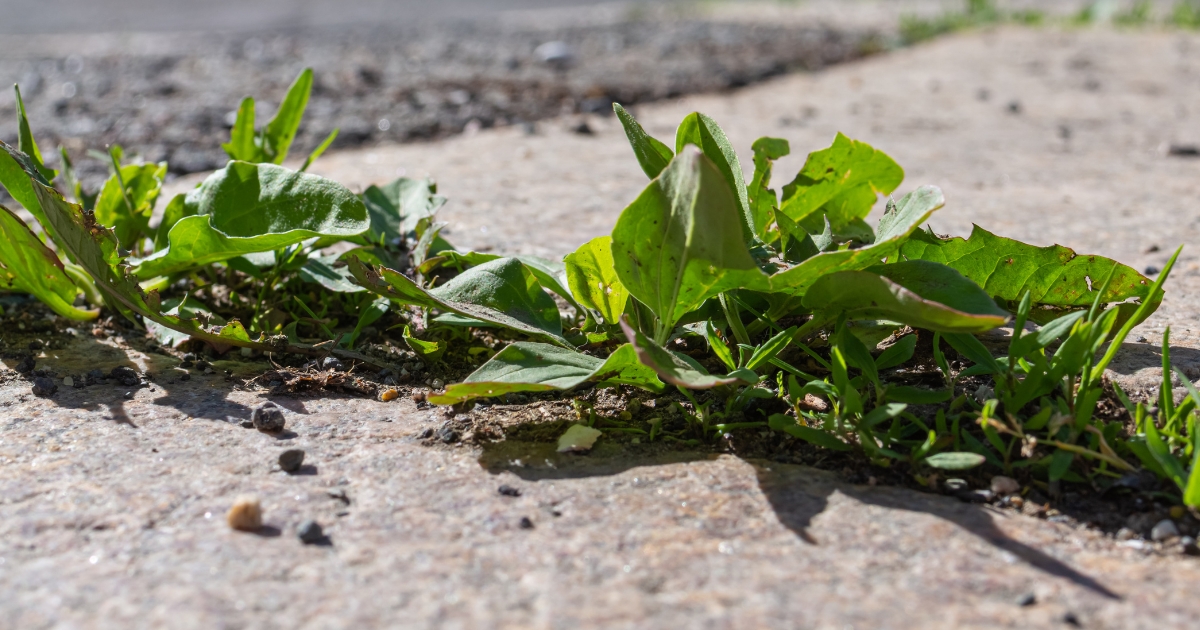News
The 8 Best Ways To Deal With Weeds On Your Driveway And Patio

Weeds can be a pesky problem on driveways, paths, and patios. Not only do they look untidy, weeds can also cause a good deal of damage if they are left to their own devices. Weeds in kerbs or around drains can prevent or slow down drainage, and growth can destroy paving surfaces, force kerbs apart and crack walls, leading to unwelcome repair costs.
While materials like imprinted concrete offer a weed-free solution, there are effective methods for dealing with weeds on other popular outdoor surfaces. In this blog post, we’ll explore the best ways to deal with weeds on your driveway and patio with some helpful tips to keep your outdoor areas weed-free and looking their best.
Keep Surfaces Weed-Free
Preventing and controlling weeds requires regular maintenance and proactive measures. By following these tips and strategies, you can effectively manage and minimise weed growth on your driveways, paths, and patios.
1. Regular cleaning
One of the simplest and most effective ways to prevent weed growth is to regularly clean your outdoor surfaces. Debris, leaves and other organic matter can create a fertile environment for weed seeds to take hold. By sweeping or brushing your driveways, paths, and patios on a regular basis, you can remove potential weed nurseries and minimise the chance of weed establishment.
Incorporating a spot of weed prevention into your outdoor maintenance routine will help preserve the cleanliness and pristine condition of your surfaces, ensuring a weed-free environment for years to come.
2. Weed control fabric
Consider using a weed control fabric underneath your driveway or patio surface. This permeable fabric acts as a barrier, preventing weed growth from underneath. It blocks sunlight and hampers weed seed germination, reducing the need for herbicides and minimising weed maintenance. Before installing the fabric, make sure the surface is properly prepared, and follow the manufacturer’s instructions for optimal results.
3. Weed-killing solutions
When weeds do make an appearance, utilising targeted weed-killing solutions can be an effective method of control. Choose herbicides specifically formulated for the type of surface you have, such as gravel-friendly weed killers or those suitable for paved areas.
Follow the instructions carefully, taking care to protect nearby plants and water sources. For maximum effectiveness, apply the herbicide when the weeds are actively growing, typically during warmer weather.
4. Mechanical removal
For smaller areas or isolated weed patches, manual removal can be an efficient and environmentally friendly option. Hand-pulling or using a weeding tool, such as a dandelion weeder or a fishtail weeder, can effectively extract weeds – roots and all.
Our top tip is to make sure to remove the entire root system. Otherwise, it will spring back to life again at some point in the future! It’s advisable to tackle weeds after rainfall when the soil is moist, as it makes it easier to extract the entire plant.
5. Regular inspections
Routine inspections are essential to catch weed growth in its early stages. Walk along your driveways, paths, and patios on a frequent basis, keeping an eye out for any emerging weeds. By identifying and addressing them early on, you can prevent their spread and minimise the need for extensive weed control measures in the future.
6. Natural weed control methods
As an alternative to chemical herbicides, you can use natural and organic weed control methods. These include techniques such as mulching, which involves applying a layer of organic materials (such as wood chips, straw, or compost) to smother weeds and prevent their growth. Additionally, hand weeding or spot treatment with boiling water can be effective for eliminating weeds in specific areas without the use of chemicals.
7. Preventing weed seed spread
To prevent the spread of weed seeds, practice good garden hygiene. Remove any mature weeds before they have a chance to disperse their seeds. Additionally, clean gardening tools and equipment thoroughly after working in weedy areas to avoid unintentional seed transport. Many local councils collect garden waste, so that’s a great way to say goodbye to your garden’s uninvited visitors.
8. Choose imprinted concrete
Our favourite tip for dealing with weeds on your drive and patio is to use a surface that remains completely weed-free! Imprinted concrete is a cost-effective and durable solution, resembling traditional materials like wood, cobblestones, and slate.
Not only is it weed-resistant, but there won’t be any sinkage and the colours will stay fast over time. It’s a versatile option for any outdoor space as it can be used in areas of any shape or size and you can choose from a wide range of shades and patterns or create a custom design.
Why use Avon Cobblestone?
At Avon Cobblestone, we are a trusted family-run business with over three decades of experience, specialising in imprinted concrete for gardens, patios, paths, and driveways. Our products seamlessly blend aesthetic appeal, affordability, durability, and are low maintenance.